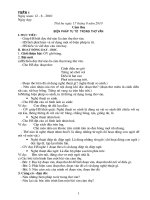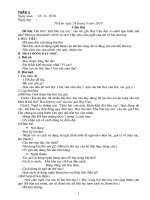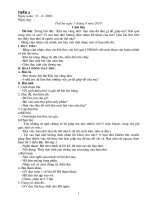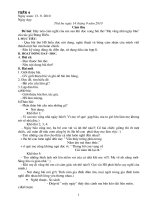Viết nâng cao 1
Bạn đang xem bản rút gọn của tài liệu. Xem và tải ngay bản đầy đủ của tài liệu tại đây (2.36 MB, 55 trang )
TRƯỜNG ĐẠI HỌC THỦY LỢI
Trung tâm Đào tạo Quốc tế - Bộ môn Tiếng Anh
Môn học: VIẾT NÂNG CAO 1
Tên giảng viên:
Vũ Thị Thu Hương
Email:
ĐT: 0988.205.366
Chapter 1: Types of sentences
Main points & Unit objectives
• Kinds of clauses: dependent clauses / independent clauses / noun clauses/adjective
clauses…..
• Kinds of sentences: simple / compound / complex…
• Sentence problems: fragments, run-ons, comma splices, choppy and stringy sentences.
• Using Parallelism and Fixing sentence Problems
I. Kinds and features of clauses
Independent clause (IC)
Dependent Clause (DC)
contains a subject and a verb
contains a subject and a verb
express a complete thought
does not express a complete thought
can stand alone as a sentence by itself
can not stand alone as a sentence by itself
S+V
Subordinator + S + V
I. Kinds and features of clauses
• What are the subordinators of DC?
After
Before
That
When
Which
Although
Even though
Though
Whenever
While
As, just as
How
Unless
Where
Who
As if
If
Until
Wherever
Whom
As soon as
since
what
Whether
Whose
Because
So that
I. Kinds and features of clauses
Practice 1:
1. Distinguish IC and DC (Prac. 1 – p.3)
2. Complete sentences, using IC or DC (Handout)
II. KINDS of SENTENCES
Freshwater boils at 100 degrees Celsius
at sea level
(simple sentence).
Salt water boils at a higher
temperature than freshwater, so
food cooks faster in salt water.
(compound sent.)
Sentences
Although women in the
United States could own
property, they could not vote
until 1920.
(complex sent.)
Although women in the United States could
own property, they could not vote until
1920; and after 1920, their vote was legal.
(compound-complex sent.)
II.1. Simple Sentences
Features:
• Have one Independent clause (IC)
• End with a stop (.)
• Basic form:
S+V
• Eg:
Freshwater boils at 100 degrees Celsius at sea level.
Freshwater boils at 100 degrees and freezes at 0 degrees Celsius.
Notes: There exist some variations of simple sentences
Practice 2: Read the paragraphs and decide
what variation each sentence belongs to
Practice 3 : Write sentences - Topic: the Internet
II.2. Compound Sentences
• two or more independent clauses joined together
• end with a stop (.)
• basic forms:
IC, coordinator IC
IC; conjunctive adverb, IC
IC; IC
Notes:
•
Coordinators (coordinating conjunctions)
For
(to add a reason)
And
Nor
But
Or
Yet
So
(to add more ideas)
(to add a negative equal idea)
(to add an alternative possibility)
(to add an unexpected or surprising continuation)
(to add an unexpected or surprising continuation)
(to add an expected result)
FAN BOYS
• Conjunctive Adverbs
Practice 4
• Ex.3, 4, 5 & 6 (p.5)
II.3. Complex Sentences
• Contain one independent clause and one (more) dependent clauses
• Independent clauses: more important ideas. /dependent clause: less important ideas
• 3 kinds of dependent clauses: noun clause, adjective clause, adverb clauses.
Examples:
Although women in the United States could own property, they could not vote until 1920.
Dependent adverb clause Independent clause
Who are not married are called bachelors.
Dependent Adjective Clause
That there is a hole in the ozone layer of Earth’s atmosphere is well known.
Dependent noun clause
Practice 5
• Ex 8, 9, 10 (p.10)
IV. Parallelism
What?
each item in a list or comparison follows the same grammatical pattern.
Eg:
1.My English conversation class is made up of Chinese, Spaniards, and some are from Bosnia.
parallel
parallel
not parallel
2. My English conversation class is made up of Chinese, Spaniards, and Bosnians.
parallel
parallel
Note:
parallel
I. Parallelism
What for?
1) economy
3) equality
2) clarity
4) delight.
I. Parallelism
How to form parallelism?
1. Use parallel structure with elements joined by Coordinators (and, or, but)
2. Use parallel structure with elements joined by Correlative (Paired)
Conjunctions
3. Use parallel structure with elements joined by a linking verb or a verb of
being.
II, Sentence Problems
1. Sentence Fragments: incomplete sentences/ parts of
sentences
2. Choppy sentences:
too short sentences
3. Stringy sentences
too many independent clauses
4. Run-on sentences and comma splies:
clauses written with
no punctuation or without a coordinating conjunction.
Practice 1: Identifying sentence problems
(p.15- p.21)





